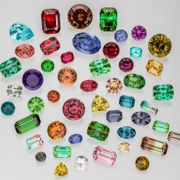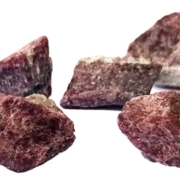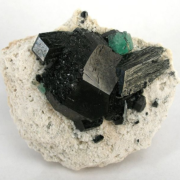Black Tourmaline (Schorl)
Black Tourmaline, scientifically known as Schorl, is a mineral that forms through a variety of geological processes. It can originate from magmatic activity, crystallizing from molten rock, or from hydrothermal processes where hot mineral-rich fluids deposit Tourmaline crystals in fractures and cavities of existing rocks. This mineral is found in diverse geological environments worldwide, including granite pegmatites, schists, and alluvial deposits. Its unique geological origins contribute to its striking black color and make it a fascinating subject for mineral enthusiasts and geologists alike.


Contents
- Formation and Occurrence of Black Tourmaline
- Properties of Black Tourmaline
- Uses and Applications
- Black Tourmaline vs. Other Gemstones
- Summary of Key Points
Formation and Occurrence of Black Tourmaline
Black Tourmaline, scientifically known as Schorl, forms through complex geological processes and can be found in various locations around the world. Here’s an overview of the formation and occurrence of Black Tourmaline:
Formation: Black Tourmaline is a member of the Tourmaline mineral group, which comprises several borosilicate minerals. Its formation involves the interaction of geological and hydrothermal processes:

- Magmatic Processes: Black Tourmaline can originate from the crystallization of molten rock (magma) deep within the Earth’s crust. As magma cools and solidifies, various minerals, including Tourmaline, can crystallize from the cooling melt.
- Hydrothermal Activity: Another common way Black Tourmaline forms is through hydrothermal activity. Hot, mineral-rich fluids seep into cracks and fractures in existing rocks. As these fluids cool and solidify, they can deposit Tourmaline crystals. This process can take place in various types of host rocks, including granite, pegmatites, and schist.
Occurrence: Black Tourmaline can be found in a wide range of geological environments and regions. Some notable occurrences include:
- Brazil: Brazil is a significant source of Black Tourmaline. It is often found in pegmatite deposits in the Minas Gerais region. These pegmatites are rich in minerals and can produce high-quality Black Tourmaline crystals.
- United States: Black Tourmaline is also found in the United States, with notable deposits in states like Maine and California. In Maine, for example, it occurs in granite pegmatites.
- Sri Lanka: Sri Lanka is famous for its Tourmaline, including Black Tourmaline. The gemstone is often found in alluvial deposits, which are sediments carried and deposited by water.
- Afghanistan: Afghanistan is another source of Black Tourmaline, particularly in the Nuristan province. Here, it is often mined in rugged mountainous terrain.
- Other Locations: Black Tourmaline can also be found in countries like Madagascar, Pakistan, Namibia, and Russia, among others. Its occurrence is associated with geological regions rich in granitic and metamorphic rocks.
It’s important to note that Black Tourmaline is not only prized for its aesthetic and metaphysical qualities but also for its various industrial applications. Its natural electrical properties make it valuable in industries like electronics and telecommunications, where it is used in devices to control static electricity.
In summary, Black Tourmaline forms through geological processes involving magma and hydrothermal fluids and can be found in a variety of geological environments worldwide. Its presence in pegmatites, granite, and other mineral-rich rocks makes it a valuable and sought-after mineral for both its beauty and practical applications.
Properties of Black Tourmaline

Black Tourmaline, also known as Schorl, possesses a range of physical, chemical, and metaphysical properties that make it a unique and highly sought-after mineral. Here are some of the key properties of Black Tourmaline:
Physical Properties:
- Color: As the name suggests, Black Tourmaline is predominantly black, although it can sometimes exhibit a deep brownish-black or bluish-black hue.
- Luster: It typically has a vitreous (glassy) luster, giving it a shiny appearance when polished.
- Hardness: Black Tourmaline ranks 7 to 7.5 on the Mohs scale of mineral hardness, making it quite durable and resistant to scratching.
- Crystal Structure: It has a trigonal crystal structure, characterized by threefold symmetry.
- Cleavage: Black Tourmaline exhibits poor to no cleavage, meaning it does not easily break along specific planes.
- Fracture: Its fracture is conchoidal, meaning it breaks with smooth, curved surfaces like glass.
Chemical Properties:
- Chemical Composition: Black Tourmaline is a complex borosilicate mineral with the general formula (Na,Ca)(Li,Mg,Fe,Al)3Al6(BO3)3Si6O18(OH)4. The specific composition can vary depending on the locality.
- Iron Content: The black color of Black Tourmaline is often due to the presence of iron impurities within its crystal structure.
Industrial Uses:
- Electronics: Due to its unique electrical properties, Black Tourmaline is used in various electronic devices to control static electricity and electromagnetic interference.
- Jewelry: It is a popular gemstone for jewelry, often used in necklaces, bracelets, and rings.
- Collector’s Item: Exceptional specimens of Black Tourmaline crystals are collected by mineral enthusiasts and collectors for their aesthetic appeal and metaphysical significance.
In summary, Black Tourmaline possesses a combination of physical and metaphysical properties that make it a versatile and valuable mineral. It is not only appreciated for its aesthetic qualities but also for its potential to provide protection, grounding, and positive energy in both spiritual and practical applications.
Uses and Applications

Black Tourmaline, known for its unique properties and striking appearance, finds a wide range of uses and applications in various fields. Here are some of the primary uses and applications of Black Tourmaline:
1. Jewelry: Black Tourmaline is commonly used in jewelry design. It is fashioned into cabochons, faceted gemstones, beads, and even carved into intricate shapes for use in rings, necklaces, bracelets, and earrings. Its deep black color adds elegance and a sense of protection to jewelry pieces.
2. Crystal Healing and Metaphysical Uses: Black Tourmaline is highly regarded in the world of crystal healing and metaphysics. It is used for various purposes, including:
- Protection: Many believe that Black Tourmaline can shield against negative energies, psychic attacks, and electromagnetic radiation. It is often carried or placed in one’s environment for protection.
- Grounding: Black Tourmaline is associated with grounding energy, helping individuals feel more connected to the Earth and balanced in their daily lives.
- Chakra Healing: It is linked to the Root Chakra (Muladhara), which is associated with stability and security. Black Tourmaline is used to balance and align this energy center.
- Meditation: Practitioners use Black Tourmaline during meditation to enhance spiritual growth, promote mental clarity, and protect against negative influences.
3. EMF Protection: Black Tourmaline is sometimes employed to shield against the harmful effects of electromagnetic fields (EMFs) generated by electronic devices such as smartphones, laptops, and Wi-Fi routers. It may be placed near these devices or worn as jewelry to mitigate potential health concerns related to EMF exposure.
4. Feng Shui: In Feng Shui practices, Black Tourmaline is utilized to create a protective barrier around homes or specific areas. It is believed to absorb negative energies and promote a harmonious environment.
5. Decorative Items: Black Tourmaline specimens, especially those with well-formed crystals, are used as decorative items. They can be displayed in homes, offices, or as part of mineral collections.
6. Industrial Applications: Because of its unique electrical properties, Black Tourmaline is used in various industrial applications:
- Static Electricity Control: It is incorporated into materials and devices to control static electricity, which is critical in industries like electronics and manufacturing.
- Piezoelectric Properties: Some Tourmaline varieties, including Black Tourmaline, exhibit piezoelectric properties, which means they generate an electrical charge when subjected to mechanical pressure. This property has applications in sensors and electronic equipment.
7. Lapidary and Gem Cutting: Skilled lapidaries use Black Tourmaline to create polished gemstones and intricate carvings for artistic and decorative purposes.
8. Collector’s Items: Exceptional specimens of Black Tourmaline, especially those with large, well-formed crystals, are highly sought after by mineral collectors and enthusiasts.
In summary, Black Tourmaline’s uses span from the decorative and spiritual to practical industrial applications. Its protective and grounding properties, along with its striking appearance, make it a versatile gemstone and mineral with a wide range of applications and significance.
Black Tourmaline vs. Other Gemstones

Black Tourmaline, with its unique properties and appearance, differs from many other gemstones in several ways. Here’s a comparison of Black Tourmaline with some commonly known gemstones:
1. Color:
- Black Tourmaline: As the name suggests, Black Tourmaline is predominantly black, although it can occasionally appear in shades of deep brownish-black or bluish-black. Its color is due to iron impurities.
- Other Gemstones: Most gemstones are known for their vibrant colors, which can range from clear and colorless (e.g., Diamond) to a wide spectrum of hues, including red (Ruby), blue (Sapphire), green (Emerald), and many others.
2. Metaphysical Properties:
- Black Tourmaline: Black Tourmaline is renowned for its metaphysical properties, particularly its ability to absorb negative energies and provide protection. It is associated with grounding, purification, and balancing chakras.
- Other Gemstones: While other gemstones may have their own metaphysical properties, they often focus on qualities like love (Rose Quartz), courage (Citrine), and communication (Aquamarine). Black Tourmaline’s protective and grounding properties are somewhat unique in the gemstone world.
3. Industrial Applications:
- Black Tourmaline: Black Tourmaline is used in industrial applications, such as controlling static electricity and electromagnetic interference in electronics and manufacturing.
- Other Gemstones: Most other gemstones do not have industrial applications related to electrical or electronic properties. Their primary use is in jewelry and decorative arts.
4. Transparency and Clarity:
- Black Tourmaline: Black Tourmaline is typically opaque, meaning it does not allow light to pass through. Its luster is vitreous (glassy).
- Other Gemstones: Many gemstones are prized for their transparency and clarity, allowing light to pass through and create sparkling, brilliant effects when cut and polished.
5. Crystal Structure:
- Black Tourmaline: It has a trigonal crystal structure, characterized by threefold symmetry.
- Other Gemstones: Different gemstones have various crystal structures, contributing to their unique optical and physical properties. For example, Diamond has a cubic crystal structure, while Quartz has a hexagonal crystal structure.
6. Use in Jewelry:
- Black Tourmaline: Black Tourmaline is used in jewelry, but its primary appeal is not its aesthetic beauty (color) but rather its metaphysical properties. It is often used in pieces where its protective qualities are desired.
- Other Gemstones: Most other gemstones are used primarily for their aesthetic appeal. They are chosen for their color, clarity, brilliance, and rarity to create stunning jewelry pieces.
In summary, Black Tourmaline stands apart from many other gemstones due to its distinctive black color, metaphysical properties, industrial applications, and lack of transparency. While other gemstones are valued primarily for their beauty and rarity, Black Tourmaline finds its niche in providing protection, grounding, and practical uses in various industries.
Summary of Key Points
- Black Tourmaline, or Schorl: Black Tourmaline is a mineral belonging to the Tourmaline family. It is known for its striking black color and is scientifically known as Schorl.
- Physical Characteristics: Black Tourmaline typically appears as elongated prismatic crystals with a deep black color. It has a vitreous luster and ranks 7 to 7.5 on the Mohs scale of mineral hardness.
- Formation and Occurrence: Black Tourmaline forms through geological processes, including magmatic and hydrothermal activity. It can be found in various regions worldwide, including Brazil, the United States, Sri Lanka, Afghanistan, and more.
- Metaphysical Properties: Black Tourmaline is renowned for its metaphysical properties, including protection against negative energies, grounding, and chakra alignment. It is often used in crystal healing and spiritual practices.
- Jewelry and Decorative Use: Black Tourmaline is commonly used in jewelry, where it is fashioned into cabochons, beads, and faceted gemstones. Its deep black color makes it attractive for both men’s and women’s jewelry.
- EMF Protection: Some people use Black Tourmaline to shield against the harmful effects of electromagnetic fields (EMFs) from electronic devices.
- Industrial Applications: Black Tourmaline’s unique electrical properties make it valuable in industries such as electronics and manufacturing, where it is used to control static electricity and electromagnetic interference.
- Collector’s Item: Exceptional specimens of Black Tourmaline crystals are highly sought after by mineral collectors and enthusiasts.
- Feng Shui and Home Decor: In Feng Shui practices, Black Tourmaline is used to create a protective barrier around homes or specific areas to absorb negative energies and promote harmony.
- Comparison with Other Gemstones: Black Tourmaline differs from many other gemstones in terms of color, metaphysical properties, industrial applications, transparency, and crystal structure.
Overall, Black Tourmaline is a versatile mineral valued for its protective qualities, grounding properties, and practical applications in various fields, ranging from jewelry and spiritual practices to industry and home decor.





Leave a Reply
Want to join the discussion?Feel free to contribute!